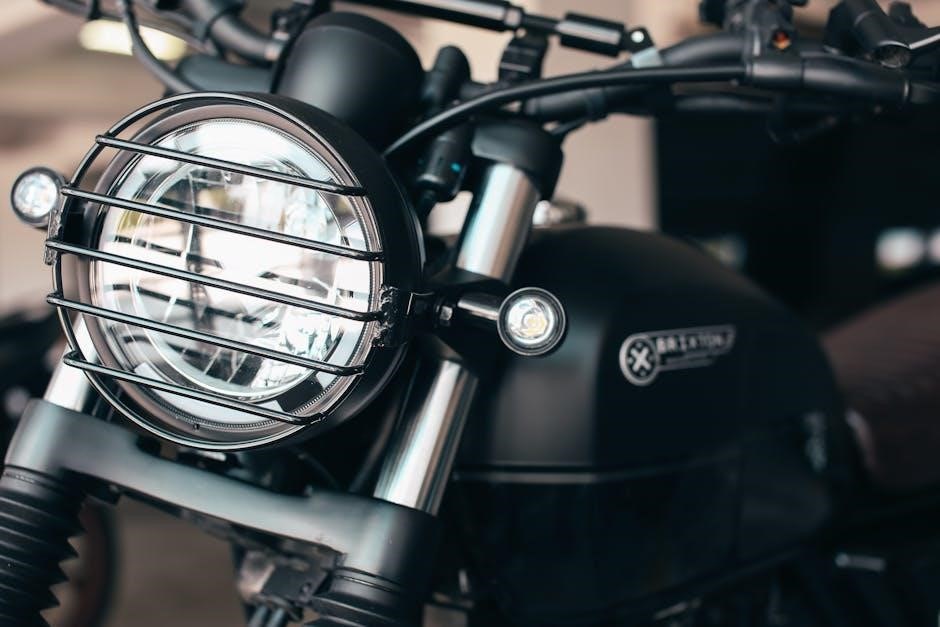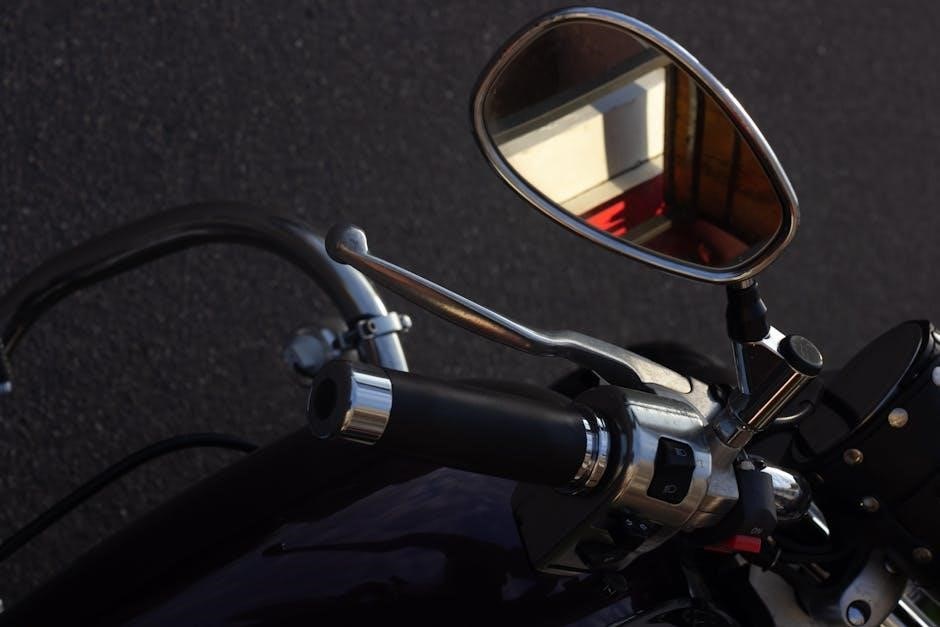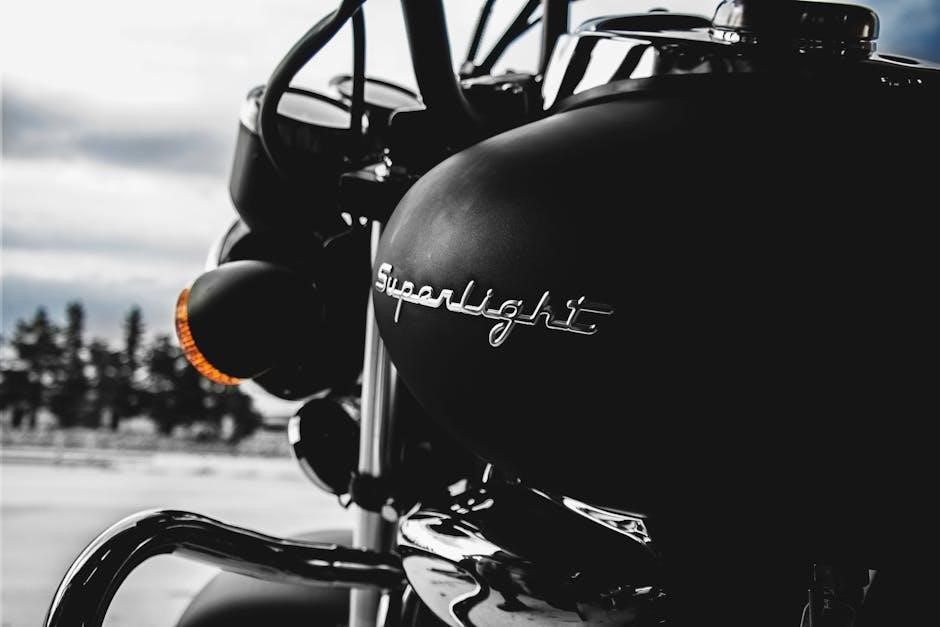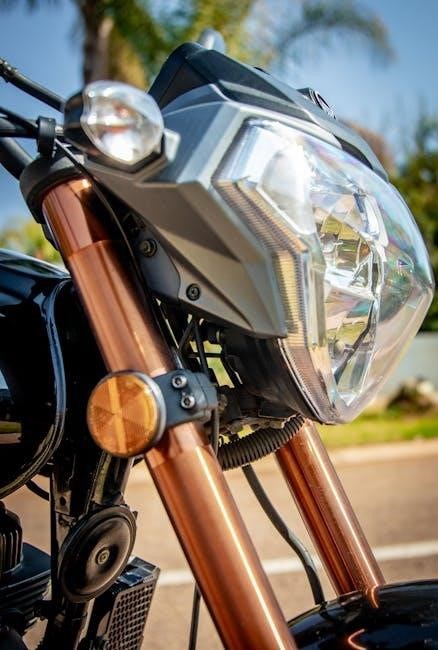Troy-Bilt riding mowers are renowned for their durability and performance, offering reliable lawn care solutions. Their parts diagrams are essential for maintenance, repairs, and upgrades, ensuring optimal functionality.
1.1 Brief Overview of Troy-Bilt Riding Mowers
Troy-Bilt riding mowers are durable and high-performance lawn care machines designed for efficiency and reliability. Known for their robust construction, these mowers cater to various lawn sizes and terrains. Models like the Horse XP and zero-turn mowers are popular for their versatility and power. Troy-Bilt mowers often feature advanced cutting decks and hydrostatic transmissions, ensuring smooth operation. Over the years, users have highlighted the importance of accurate parts diagrams for maintenance and repairs, as locating specific components can be challenging. Despite their reliability, issues like uneven cutting or brake problems occasionally arise, making access to detailed diagrams crucial for DIY fixes. This overview sets the stage for understanding the essential role of parts diagrams in maintaining these mowers.
1.2 Importance of Parts Diagrams for Maintenance and Repair
![]()
Parts diagrams are crucial for the proper maintenance and repair of Troy-Bilt riding mowers. These visual guides provide a detailed breakdown of components, making it easier to identify and locate specific parts. Whether diagnosing issues like uneven cutting or addressing common problems such as stuck brakes, a parts diagram ensures accuracy. It prevents purchasing incorrect replacements, saving time and money. Additionally, diagrams guide users through complex repairs, reducing the risk of further damage. For DIY enthusiasts and technicians alike, parts diagrams are indispensable tools, ensuring that maintenance and repair tasks are performed safely and effectively. Regular reference to these diagrams helps extend the lifespan of the mower.

Understanding the Troy-Bilt Riding Mower Parts Diagram
The parts diagram is a visual guide detailing the mower’s components and their relationships. It organizes parts into sections, aiding in identification and repair processes effectively.
![]()
2.1 Structure and Components of the Parts Diagram
The Troy-Bilt riding mower parts diagram is structured to provide a clear visual representation of the mower’s components. It is typically divided into sections, such as the engine, cutting deck, and transmission, with each part numbered for easy identification. The diagram includes symbols and notations to indicate connections, such as bolts, screws, and hoses, helping users understand how components interact. Additionally, it often features a parts list with corresponding numbers, making it easier to locate and order replacement parts. The diagram’s layout is designed to simplify troubleshooting and repairs by visually mapping out the mower’s anatomy. This tool is indispensable for maintaining and servicing the mower effectively.
2.2 How to Read and Interpret the Diagram
Reading and interpreting the Troy-Bilt riding mower parts diagram requires a systematic approach. Start by identifying the model number of your mower, as diagrams are typically model-specific. Use the diagram’s index or parts list to locate the component you need; Each part is numbered and corresponds to a description in the parts list. Symbols, such as arrows or dotted lines, indicate connections or assembly points. Cross-reference the diagram with your mower to ensure accuracy. Pay attention to color-coded sections, which may highlight specific systems like the engine or transmission. By following these steps, you can efficiently identify and locate the parts you need for maintenance or repair.
2.3 Key Symbols and Notations Used in the Diagram
The Troy-Bilt riding mower parts diagram utilizes a variety of symbols and notations to convey information clearly; Common symbols include gears, pulleys, and arrows, which indicate mechanical linkages or flow directions. Numbers are assigned to each part, corresponding to the parts list for easy identification. Dotted lines often represent hidden components or connections. Color-coded sections may differentiate between systems, such as the engine or transmission. Additionally, asterisks or other markers highlight optional or interchangeable parts. Understanding these symbols is crucial for accurate interpretation, ensuring users can locate and replace parts efficiently. Always refer to the legend or key provided with the diagram for a detailed explanation of each symbol. This enhances the overall usability of the diagram for maintenance and repair tasks.

Common Parts and Accessories for Troy-Bilt Riding Mowers
Common parts include blades, engines, and transmission components; Accessories like belts and pulleys are also essential. Always use the parts diagram for accurate identification and maintenance.
3.1 Blades and Cutting Deck Components
The cutting deck and blades are critical for efficient mowing. Dull or damaged blades can lead to uneven cuts, while a worn cutting deck affects performance. Regular maintenance, such as sharpening or replacing blades, is essential. Referencing the parts diagram ensures correct replacement parts are identified. The diagram details blade types, deck belts, and pulleys, making repairs straightforward. Proper care extends the lifespan of these components, ensuring optimal cutting results. Always use genuine Troy-Bilt parts for compatibility and durability.
3.2 Engines and Fuel System Parts
The engine and fuel system are vital for the operation of Troy-Bilt riding mowers. Key components include the engine block, fuel tank, carburetor, and spark plugs. Regular maintenance, such as cleaning or replacing air and fuel filters, ensures optimal performance. The parts diagram provides a detailed breakdown of these components, making it easier to identify and replace worn or damaged parts. Issues like poor engine performance or difficulty starting often relate to the fuel system. Using genuine Troy-Bilt parts, as specified in the diagram, guarantees compatibility and reliability. Always refer to the diagram for correct part numbers and installation guidance to maintain your mower’s efficiency and longevity.
3.3 Transmission and Drive System Components
The transmission and drive system are crucial for the mobility and functionality of Troy-Bilt riding mowers. These components include gears, belts, pulleys, and hydrostatic transaxles. The parts diagram provides a clear visual guide to identify and locate each part, ensuring accurate repairs. Common issues like slow movement or loss of traction can often be traced to worn belts or faulty transaxles. Regular lubrication and inspection of these components are essential for maintaining smooth operation. Using the diagram, users can pinpoint problems and order the correct replacement parts, such as belts or gear assemblies, to keep their mower running efficiently and effectively. Proper maintenance extends the lifespan of these critical systems.

Troubleshooting Common Issues Using the Parts Diagram
The parts diagram is a valuable tool for troubleshooting common issues like faulty starters or uneven cutting. It helps identify and locate problematic components quickly and efficiently.
4.1 Diagnosing Issues with the Mower Not Starting
If your Troy-Bilt riding mower fails to start, begin by checking the fuel level and ensuring the mower is in neutral gear. Refer to the parts diagram to locate the air filter and spark plug, as these are common culprits. Clean or replace the air filter if dirty and check the spark plug for wear or corrosion. Use the diagram to identify the ignition system components, such as the coil or starter solenoid, and test for continuity. If the issue persists, consult the parts diagram to inspect the brake safety switch or seat switch, which may prevent the mower from starting if malfunctioning. Always follow safety precautions and consider professional assistance if troubleshooting efforts fail.

4.2 Identifying Causes of Uneven Cutting Patterns
Uneven cutting patterns on your Troy-Bilt riding mower can be frustrating. Start by examining the cutting deck using the parts diagram to locate the blades and deck belt. Dull or damaged blades should be replaced, while a loose or worn belt may need adjustment or replacement. Check the deck pulleys and spindle for wear, as these can cause uneven cuts. Ensure the mowing deck is properly leveled, as an unbalanced deck can lead to inconsistent results; Consult the diagram to verify the correct blade installation and deck adjustments. If issues persist, inspect the transmission for proper drive engagement. Regular maintenance and accurate part replacement can restore even cutting performance.
4.3 Troubleshooting Transmission and Drive Problems
Transmission and drive issues can hinder your Troy-Bilt riding mower’s performance. Start by checking the drive belt and pulleys for wear or misalignment using the parts diagram. If the mower struggles to move, inspect the transmission fluid level and top it off if necessary. For hydrostatic models, ensure the hydrostatic fluid is at the recommended level. Consult the diagram to locate the transmission components and verify proper engagement of the drive system. If issues persist, check for blockages in the drive system or damage to the transmission gears. Refer to the parts diagram for accurate repairs and consider replacing worn or damaged parts to restore smooth operation.
![]()
Maintenance and Repair Using the Parts Diagram
Regularly inspect and replace worn parts like belts and pulleys using the diagram. Check oil levels and filters, and sharpen blades for optimal performance.

5.1 Regular Maintenance Schedule and Checklist
A well-structured maintenance schedule is crucial for extending the lifespan of your Troy-Bilt riding mower. Begin by referencing the parts diagram to locate key components. Oil changes should be performed every 50 hours of operation, ensuring the engine remains lubricated. Air filters must be cleaned or replaced monthly to maintain proper airflow. Sharpen or replace blades seasonally to ensure clean cuts and prevent damage to the mower deck. Check belt and pulley alignment regularly, as misalignment can lead to premature wear. Finally, inspect the transmission fluid levels and top them off as needed. Regular tire pressure checks and deck lubrication will keep your mower running smoothly. Always refer to the parts diagram for precise locations and procedures.
5.2 DIY Repair Tips for Common Parts
DIY repairs can save time and money when maintaining your Troy-Bilt riding mower. Start by consulting the parts diagram to identify components like blades, belts, and pulleys. For blade replacement, sharpen or swap them using the diagram to ensure proper alignment. Inspect and replace worn belts, checking for cracks or fraying. When addressing pulley issues, ensure they are correctly aligned to prevent uneven wear. Use the diagram to locate bolts and fasteners, tightening them to the recommended torque specifications. Always refer to the parts diagram for accurate part numbers and compatibility. Regularly checking oil and fuel systems can prevent common issues. DIY repairs are cost-effective but require careful adherence to instructions to avoid further damage.
5.3 Knowing When to Seek Professional Assistance
While DIY repairs are cost-effective, certain issues require professional expertise. If your Troy-Bilt riding mower experiences complex problems like transmission failure or hydrostatic system leaks, consult a certified technician. Additionally, if engine performance declines significantly or electrical components malfunction, professional assistance is advisable. Attempting these repairs without proper knowledge can lead to further damage or safety hazards. Always refer to the parts diagram to understand the complexity of the issue. If unsure, contact Troy-Bilt’s customer support or visit an authorized service center. Professional help ensures repairs are done safely and efficiently, extending your mower’s lifespan. Regular maintenance can prevent many issues, but knowing when to seek help is crucial for optimal performance and longevity.

Accessing and Utilizing the Parts Diagram
Accessing Troy-Bilt riding mower parts diagrams is straightforward via official resources or third-party websites. Use the part finder tool to select your model and year, then browse detailed diagrams to identify components efficiently.
6.1 Official Troy-Bilt Resources for Parts Diagrams
Troy-Bilt provides official resources for accessing detailed parts diagrams, ensuring authenticity and accuracy. Visit the Troy-Bilt official website and use the Part Finder tool to search by model number or serial number. Select your mower’s model and year to access interactive diagrams that map out every component. These diagrams are linked to the official parts catalog, allowing users to identify and purchase genuine replacement parts directly. Additionally, the official Troy-Bilt support page offers downloadable PDF manuals and parts lists for various models. This resource is invaluable for DIY enthusiasts and professionals alike, ensuring precise repairs and maintenance. Always verify the model specifics to avoid mismatched parts.
![]()
6.2 Third-Party Websites and Tools for Parts Lookup
Several third-party websites offer comprehensive tools for locating Troy-Bilt riding mower parts diagrams and components. Websites like PartsTree and RepairClinic provide detailed diagrams and part lists for various Troy-Bilt models. These platforms allow users to search by model number or part number, ensuring accurate results. Additionally, forums and communities dedicated to outdoor power equipment often share PDF diagrams and repair guides. These resources can be particularly useful for older or discontinued models. While official resources are recommended for authenticity, third-party tools offer cost-effective solutions and alternative perspectives for repairs and maintenance. Always verify the credibility of third-party sources to ensure accuracy and compatibility with your specific mower model.
6.3 Using Mobile Apps for Parts Identification
Mobile apps have become a convenient tool for identifying parts and accessing diagrams for Troy-Bilt riding mowers. Apps like PartsTree and RepairClinic offer mobile-friendly interfaces to browse and search for parts. Users can input their mower model or serial number to view detailed diagrams and part lists. Some apps also allow users to download PDF manuals and diagrams directly to their devices. For example, the Troy-Bilt Horse XP and LTX-1842 models are frequently supported in these apps. This mobility enables homeowners to identify and order parts on the go, streamlining the repair process. Always ensure the app is reputable and the information is model-specific for accuracy.
![]()
Tips for Effectively Using the Parts Diagram
To maximize efficiency with the parts diagram, always cross-reference part numbers with the manufacturer’s database. Ensure compatibility by verifying model and year specifications. Use official Troy-Bilt resources for accuracy.
7.1 Identifying Correct Part Numbers and Compatibility
To ensure a seamless repair or maintenance process, identifying the correct part numbers and verifying compatibility is crucial. Troy-Bilt parts diagrams provide detailed lists of components, each associated with specific model and serial numbers. By referencing the official Troy-Bilt parts catalog or the manufacturer’s website, users can accurately determine the correct part numbers for their specific mower model. Compatibility is essential to avoid installation issues or potential damage to the machine. Always double-check the part numbers against the parts diagram and the mower’s manual. This step ensures that the replacement parts function as intended and maintain the overall performance of the riding mower.
7.2 Ordering Replacement Parts Online

Ordering replacement parts online for your Troy-Bilt riding mower is a convenient and efficient process. Start by using the parts diagram to identify the exact part numbers needed for your model. Visit the official Troy-Bilt website or reputable third-party retailers, where you can input your mower’s model number to access a detailed parts list. Select the required components and proceed to checkout. Ensure compatibility by cross-referencing the part numbers with your mower’s specifications. Most online retailers offer secure payment options and fast shipping, making it easy to get the parts delivered directly to your doorstep. Always verify the authenticity of the parts to ensure they are genuine and designed for your specific model. This streamlined process saves time and ensures your mower is repaired quickly and effectively.
7.3 Safety Precautions When Working with Parts Diagrams
When using a Troy-Bilt riding mower parts diagram, it’s crucial to follow safety precautions to avoid accidents. Always disconnect the battery and ensure the mower is turned off before starting any maintenance or repairs. Wear protective gear, such as gloves and safety glasses, to prevent injuries from sharp edges or tools. Familiarize yourself with the parts diagram to understand the location and function of each component. Never attempt to modify or bypass safety features, as this can lead to serious hazards. If a procedure seems complex, consult the owner’s manual or seek professional assistance. Properly dispose of any discarded parts and keep loose clothing tied back to avoid entanglements. By adhering to these guidelines, you can ensure a safe and successful repair process.
Regular maintenance using parts diagrams ensures longevity and optimal performance of Troy-Bilt riding mowers. Always follow safety guidelines and use official resources for accurate repairs and upgrades.
8.1 Summary of Key Takeaways
The Troy-Bilt riding mower parts diagram is a crucial tool for maintaining and repairing your equipment. It provides a clear visual guide to identify components, ensuring accuracy in part replacement. Regular maintenance, as outlined in the diagram, is essential for optimal performance and longevity. Always refer to official Troy-Bilt resources or trusted third-party tools for the most accurate and up-to-date information. Understanding how to interpret the diagram correctly can save time and reduce errors during repairs. By following the guidelines and safety precautions outlined, you can ensure your mower operates efficiently and safely. Proper use of the parts diagram is key to extending the life of your Troy-Bilt riding mower.

8.2 Importance of Regular Maintenance for Longevity

Regular maintenance is vital to ensure the longevity and optimal performance of your Troy-Bilt riding mower. By adhering to a consistent maintenance schedule, you can prevent premature wear and tear on critical components. Checking and replacing parts, such as blades and oil filters, as outlined in the parts diagram, helps maintain efficiency and prevents costly repairs. Proper lubrication of moving parts and regular inspection of the cutting deck and transmission system are also essential. A well-maintained mower not only lasts longer but also performs better, ensuring a neatly manicured lawn with minimal effort. Overlooking maintenance can lead to unexpected breakdowns and reduced lifespan, making routine care a worthwhile investment.